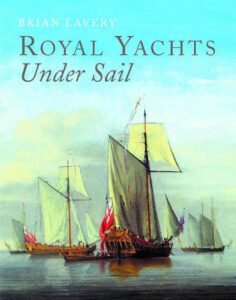- Author
- Book reviewer
- Subjects
- History - general, Book reviews
- Tags
-
- RAN Ships
- None noted.
- Publication
- September 2023 edition of the Naval Historical Review (all rights reserved)
Royal Yachts Under Sail by Brian Lavery, Seaforth Publishing, Bransley, 2022.
 A well-presented hardcover using quality paper enhancing colourful pictures and illustrations. While only 160 pages it packs a huge punch with a fascinating narrative telling the origins of the humble Dutch ‘jacht’ transposed into a beautifully crafted vessel designed for noble transport.
A well-presented hardcover using quality paper enhancing colourful pictures and illustrations. While only 160 pages it packs a huge punch with a fascinating narrative telling the origins of the humble Dutch ‘jacht’ transposed into a beautifully crafted vessel designed for noble transport.
Brian Lavery knows his subject as for many years he was senior curator at the National Maritime Museum at Greenwich. This is the story of British royal yachts, of which there has been an immense number, starting with Mary in 1660 and ending when Britannia was withdrawn from service in 1997.
Using not overly technical language the author helps explore design and construction, accommodation and furnishing, the manning and sailing characteristics of these unique vessels. Of all the royal dockyards Deptford was favoured to build royal yachts as it had a standard of craftsmanship unequalled in other yards.
Charles Stuart, son of King Charles I (he that lost his head) escaped his persecutors by sailing across the Channel in a lowly collier. During nine years in exile the young prince took an interest in small fast Dutch yachts. Hence with the restoration of the British monarchy he was able build his own squadron of yachts.
The first royal yacht was the Dutch built Mary but it was not long before the locally built Katherine was launched from Deptford. This private squadron of small luxury vessels used by the sovereign and senior family members continued to expand until thirteen yachts were in service with a total complement of 210 men, averaging 16 men each, and when royal personages embarked, supplemented by palace kitchen staff. They were important to the royal purse as these vessels and their upkeep were charged to the naval budget.
A favourite yacht builder was Anthony Deane. Included in his designs were Cleveland and Portsmouth, named after duchesses and mistresses of the king; the name of another yacht, Fubbs (chubby), was a pet name for the Portsmouth duchess.
When Tsar Peter the Great visited England and Holland in 1698 to study shipbuilding he was gifted the yacht Royal Transport. She was of advanced design and one of the fastest ships of her age, and carrying 18 guns, was also classed as a 6th rate ship-of-the-line. She sailed for Russia carrying 150 British seamen and shipwrights providing the nucleus for a Russian navy based on her design.
Yachts were used for work and pleasure and diplomatic purposes such as ferrying future royal brides from the continent to meet their new British (Hanoverian) spouses. The early Hanoverians who were uncomfortable speaking English liked taking extensive holidays in their homelands using up to five yachts for the royal entourage. The yacht Royal Caroline transported George II who was the last British monarch to lead his troops into battle at Dettingen. Another important venture came after the removal of Napoleon, conveying the future King Louis XVIII to reclaim his throne.
When Queen Victoria first visited Scotland in 1842 the Admiralty chartered the steamer Trident to convey the royal party and another steamer Monarch for the extensive royal luggage. Her Majesty declined Trident, insisting on using the trusted sailor Royal George, but agreed to the use of Monarch. Royal George departed from Woolwich being towed downstream by a steam tug. The squadron led by Royal George included nine naval steam vessels.
For the return voyage Her Majesty was persuaded to use the larger and more comfortable Trident which soon left the remainder of the squadron in her wake. They arrived safely at Woolwich where carriages took them to Paddington and then steam train to Windsor. The Queen was now fully converted to steam and wasted no time in suggesting to her Prime Minister Sir Robert Peel the need for a new steam driven royal yacht.
The first Victoria and Albert was a paddle wheeler launched at Pembroke Dock in 1843 but with Victoria’s long reign there were two replacements with the same name. The last was extensively used by King Edward VII and survived for more than half a century. The next monarch, King George V, used yachts sparingly and his son King Edward VIII had little interest. King George VI and Queen Elizabeth made a state visit to France in July 1938 using the Admiralty yacht Enchantress but later that month used Victoria and Albert III for Cowes Week, and then taking the royal family to Aberdeen for Balmoral. In September 1938 the Royal Navy called upon its Reserves in preparation for war and Victoria and Albert was laid up.
It was not until the accession of Queen Elizabeth II that discussions took place regarding another royal yacht. Marking the new age, HMY Britannia was launched in April 1953; of magnificent design, she travelled widely making over 600 overseas visits. Her last task was to witness the lowering of the Union flag over Hong Kong in 1997 after which she was withdrawn, becoming a museum ship in Leith, not far from where Queen Victoria landed in 1842. And with this the fabulous age of British royal yachts was over.
Whether read for enjoyment or research this book will become a wonderful companion, complete with an excellent bibliography, notes and a comprehensive index. Possibly the best of this genre and is thoroughly recommended.
Reviewed by Arcturus




